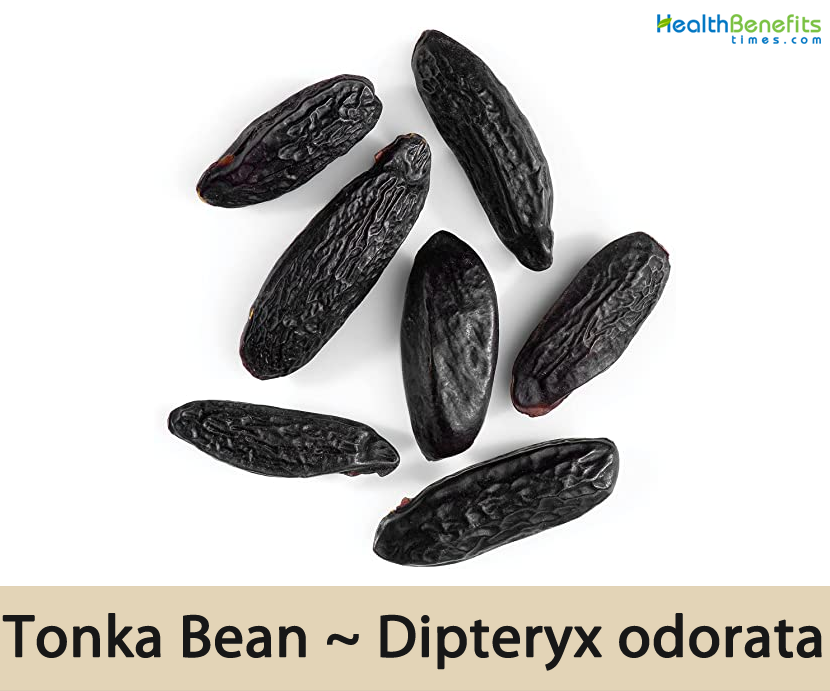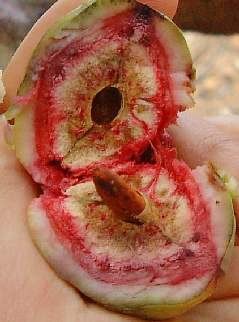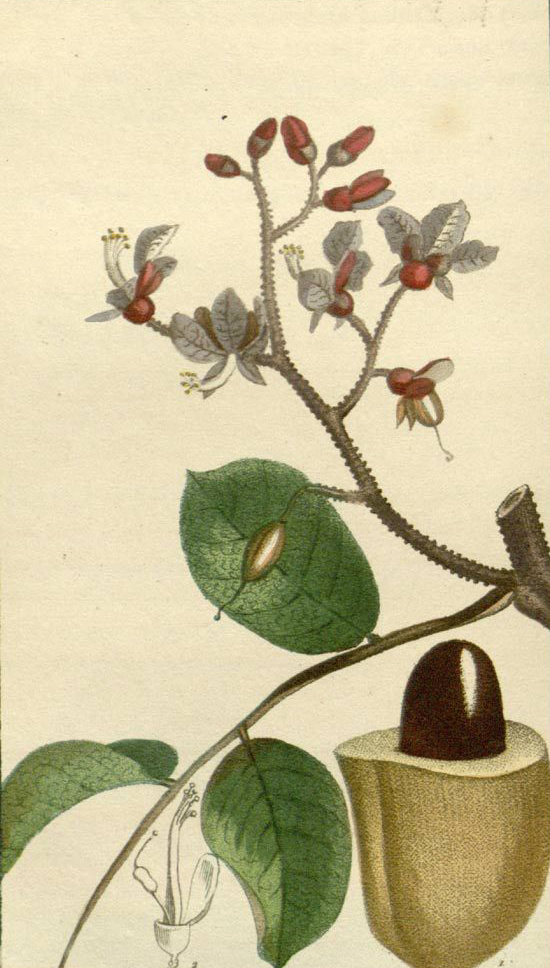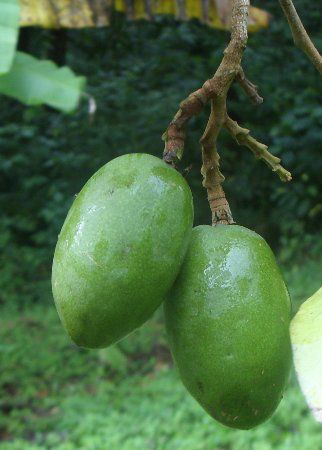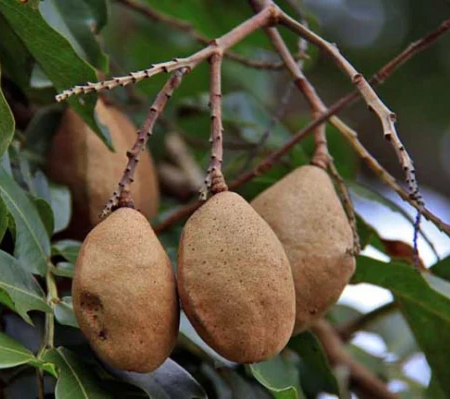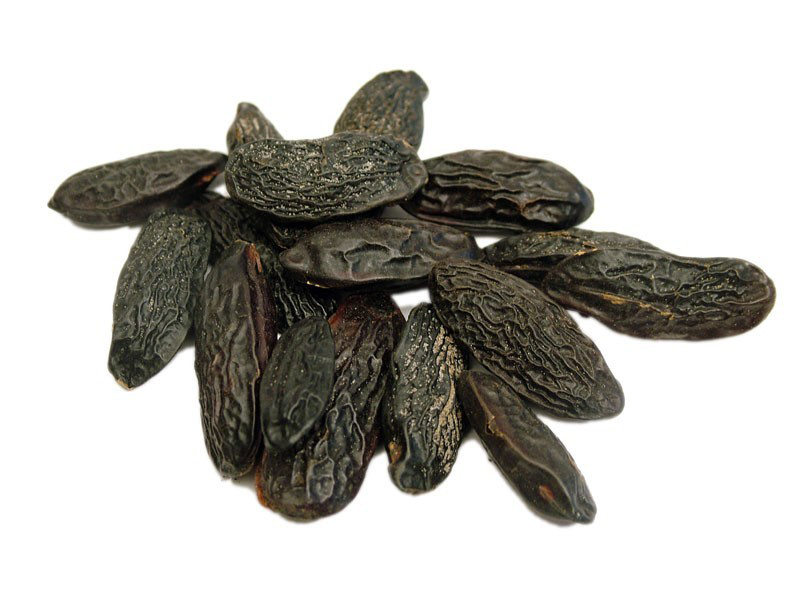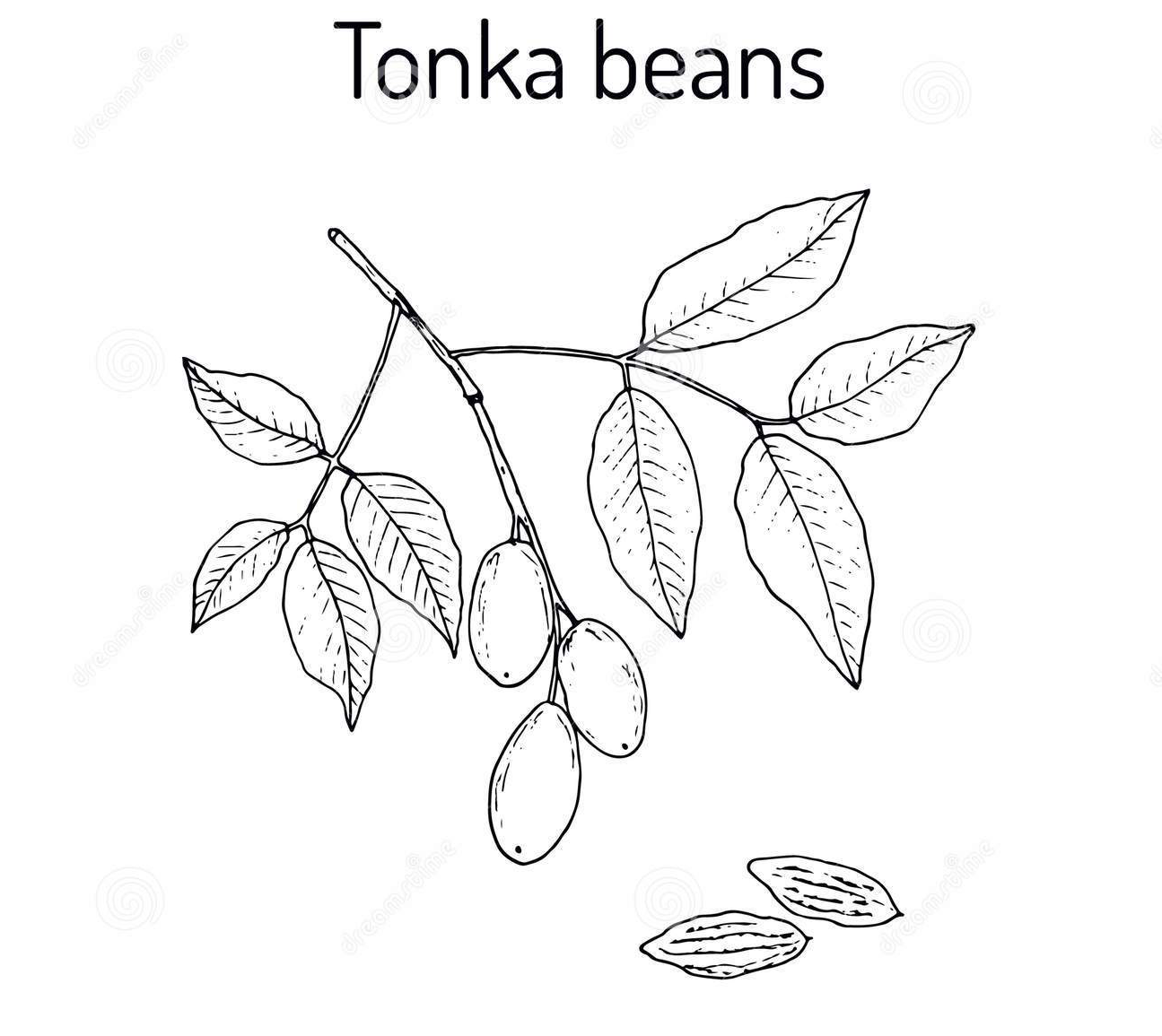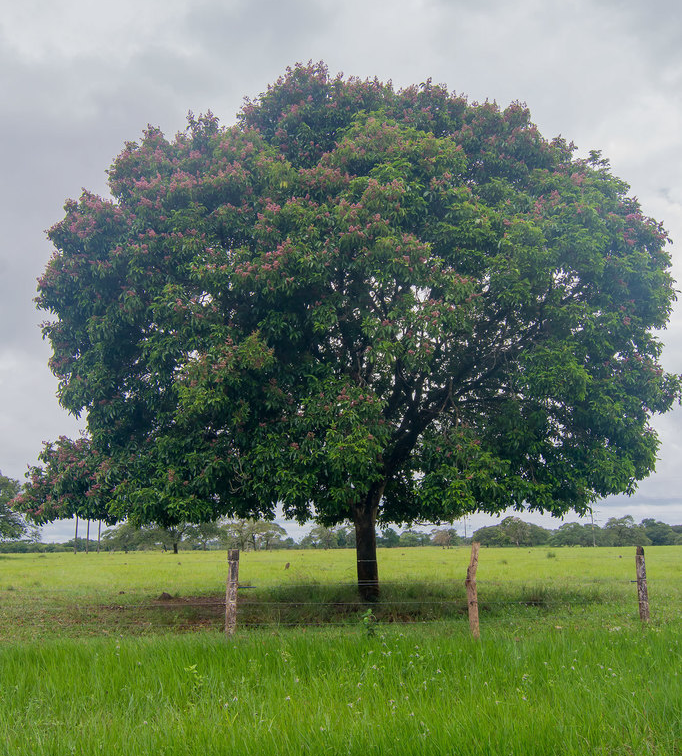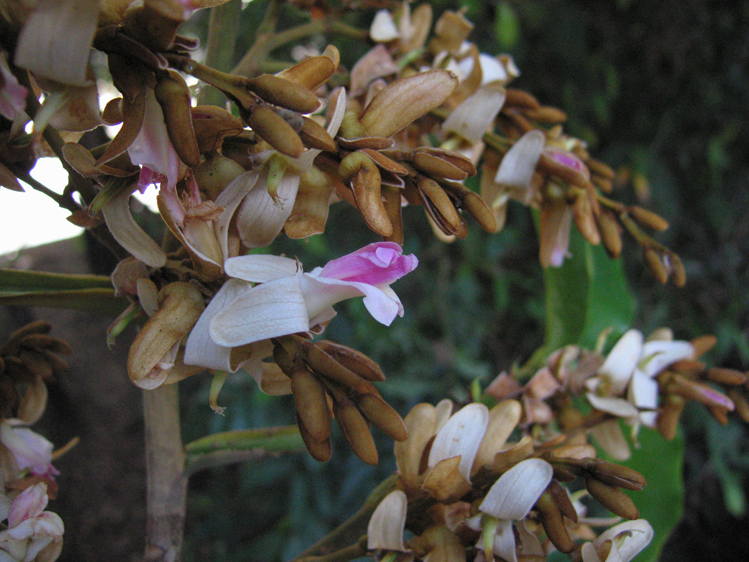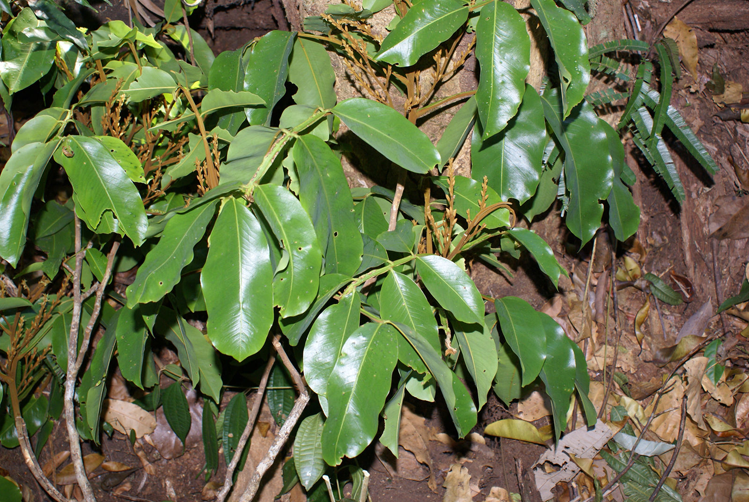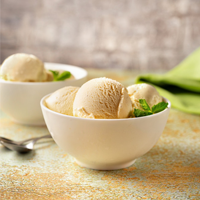The word “tonka” is taken from the Galibi (Carib) tongue spoken by natives of French Guiana. It also appears in Tupi, another language of the same region, as the name of the tree. The old genus name, Coumarouna, was formed from another Tupi name for tree, kumarú. Its seeds are known as tonka beans (sometimes Tonkin beans or tonquin beans). They are black and wrinkled and have a smooth, brown interior. They have a strong fragrance similar to sweet woodruff due to their high content of coumarin. Their fragrance is reminiscent of vanilla, almonds, cinnamon, and cloves. Many anticoagulant prescription drugs, such as warfarin, are based on 4-hydroxycoumarin, a chemical derivative of coumarin initially isolated from this bean. Coumarin, however, does not have anticoagulant properties.
Tonka Beans Facts
| Tonka Bean Quick Facts | |
|---|---|
| Name: | Tonka Bean |
| Scientific Name: | Dipteryx odorata |
| Origin | Central America and northern South America (Venezuela, Guyana, and Brazil) |
| Colors | Gray to black |
| Shapes | Almond-shaped seeds black and wrinkled and have a smooth brown interior |
| Taste | Aromatic, bitter, sweet taste |
| Health benefits | Support stomach pain, cough, dysentery, earache, cramps and nausea, depression, fevers, rheumatism, cacoethes, cancers, indurations, tumors and tuberculosis |
| Name | Tonka Bean |
|---|---|
| Scientific Name | Dipteryx odorata |
| Native | Central America and northern South America (Venezuela, Guyana, and Brazil) |
| Common Names | Tonka Bean, Brazilian Teak, Kumaru, Cumarú de Cheiro, Cumaru, Tonco bean, Tonco seed, Tonga bean, Tongo bean, Tonquin bean, Torquin bean, Amburana, Imburana De Cheiro, Charapilla, Cumaruzeiro, Rumara, Sarapia, Shihuahuaco, Tonka Bean Tree, Yape, Cimaru, Coumarou, Dutch Tonka bean, Gaiac, Guayac, Karapa Bossi, Muirapaye, Choiba, Sarrapia |
| Name in Other Languages | Afrikaans: Tonka boontjie Albanian: Fasule tonka Amharic: Tonika bak’ēla (ቶንካ ባቄላ) Arabic: Tonka bean, فول التونكا Armenian: Tonka lobi (տոնկա լոբի) Azerbaijani: Tonka lobya Bengali: Ṭaṅkā śima (টঙ্কা শিম) Brazil: Cumaru, cumarurana, cumbaru, muimapagé Bulgarian: Tona bob (тона боб) Burmese: Tonka bean ko Catalan: Fava tonca Chinese: Líng líng xiāng dòu (零陵香豆), Xiāng èr chì dòu (香二翅豆) Croatian: Tona grah Czech: Tonka fazole, silovoň obecný Danish: Tonka bønne Dutch: Tonka Boon English: Tonka bean, Tonka, Dutch Tonka Bean, Taquin Butter, Tonquin Bean, Tonga-bean Esperanto: Tonka fazeolo, Tonka fabo Estonian: Tonka oa Filipino: Tonka bean Finnish: Tonka papu, Tuoksutonkapuu French: Fève tonka, Coumaron, bois coumarou, diptéryx odorant, fève de Tonka, gaïac de Cayenne Georgian: T’onk’a lobio (ტონკა ლობიო), Tonkabohne, Tonkabohnenbaum German: Tonkabohne, Tonkabohnenbaum Greek: Fasóli tón ka (φασόλι τόνκα) Gujarati: Ṭōnkā bīna (ટોન્કા બીન) Hausa: Wake tonka Hebrew: שעועית טונקה, טונקה Hindi: Kumaaru ke beej (कुमारु के बीज) Hungarian: Tonka bab Icelandic: Tonka baun, Tonkabaunir Indonesian: Kacang tonka Irish: Bean tonka Italian: Fava tonka Japanese: Tonka mame (トンカ豆), Tonkabīnzu (トンカビーンズ) Javanese: Kacang buncis tonka Kannada: Ṭoṅkā huruḷi (ಟೊಂಕಾ ಹುರುಳಿ) Kazakh: Tonka burşağı (тонка бұршағы) Korean: Tonka kong (톤카 콩), kumalu (쿠마루) Kurdish: Tonka bean Lao: Thouangok (ຖົ່ວງອກ) Latin: Faba quoque tonka Latvian: Tonka pupiņa Lithuanian: Tonka pupelė Macedonian: Ton hrav (тон грав) Malagasy: Tsaramaso tonka Malay: Tonka kacang Malayalam: Tēāṅka bīn (ടോങ്ക ബീൻ) Maltese: Fażola Tonka Marathi: Tonka been (टोंका बीन), tonk baiain Mongolian: Buurtsag (буурцаг) Nepali: Tanka been (टन्का बीन) Norwegian: Tonka bønne Oriya: ଟନ୍କା ବିନ୍ | Pashto: ټنکا لوبیا Persian: لوبیای تنکا, لوبیای تونکا Polish: Ziarna tonka, Tonkowiec Wonny Portuguese: Fava tonka, Cumaru, Cumaruzeiro, cumaru ferro, fava-de-tonka, feijão-de-tonka, cumaru-amarelo, cumaru-verdadeiro Punjabi: Ṭōṅkā bīna (ਟੋਂਕਾ ਬੀਨ) Romanian: Boabe Tonka Russian: Boby tonka (бобы тонка), Dipteriks duşistıy (Диптерикс душистый) Serbian: Tonka grakh (тонка грах) Sindhi: ٽوکا بين Sinhala: Tonkā bōṁci (ටොන්කා බෝංචි) Slovenian: Tonka fižol Spanish: Haba tonka, Sarrapia, Cumaru, Shihuahuaco, tonga, yape, almendro Sudanese: Kacang kacangan tonka Swedish: Tonka bönor, Tonkaböna Tajik: Lūbyëy tonka (лӯбиёи тонка) Tamil: Ṭōṉkā pīṉ (டோன்கா பீன்) Telugu: Ṭōṅkā bīn (టోంకా బీన్) Thai: T̄hạ̀w th ngk̂ā (ถั่วทงก้า) Turkish: Tonka fasulyesi Ukrainian: Tonka kvasolya (тонка квасоля) Urdu: ٹنکا بین Uzbek: Tonka loviya Vietnamese: Dậu tonka Welsh: Ffa tonka Zulu: Ithonsi ubhontshisi |
| Plant Growth Habit | Tropical, semi-deciduous or semi-evergreen flowering tree |
| Growing Climates | Rainforests, often beside rivers |
| Soil | Succeeds in a wide range of soils as long as they are well-drained, though it prefers a well-drained gravelly or sandy acid soil with ample rainfall and humidity. Established plants can tolerate a certain amount of drought |
| Plant Size | Up to 30 metres tall but with some specimens up to 50 meters. The straight, cylindrical bole is unbuttressed; it can be unbranched for 18 – 24 meters and is usually 45 – 75 cm in diameter, though diameters up to 100cm have been found |
| Bark | Smooth and grey bark |
| Leaf | Alternate as well as pinnate having three to six leaflets arranged on either sides of a common axis. The leaves are leather-like (rubbery), shiny and have a deep green color |
| Flowering season | March and May |
| Flower | Purple or pink hued flowers of this tree have resemblance to a pea and characteristically they blossom during the period between the late spring and the end of summer |
| Fruit Shape & Size | Almond-shaped seeds black and wrinkled and have a smooth brown interior |
| Fruit Color | Gray to black |
| Propagation | By seed |
| Flavor/Aroma | Fragrant odor |
| Taste | Aromatic, bitter, sweet taste |
| Plant Parts Used | Seeds, bark |
| Season | June and July |
| Health Benefits |
|
Plant Description
Tonka bean is a tropical, semi-deciduous or semi-evergreen flowering tree with a small, rounded crown, generally growing up to 30 meters tall but with some specimens up to 50 meters. The straight, cylindrical bole is unbuttressed; it can be unbranched for 18 – 24 meters and is usually 45 – 75 cm in diameter, though diameters up to 100 cm have been found. The tree bark is smooth and gray, whereas the wood is red. The plant is found growing in rainforests and often beside rivers. The plant succeeds in a wide range of soils as long as they are well-drained, though it prefers a well-drained gravelly or sandy acid soil with ample rainfall and humidity. Established plants can tolerate a certain amount of drought.
Leaves
Leaves of Tonka beans are alternate as well as pinnate having three to six leaflets arranged on either sides of a common axis. The leaves are leather-like (rubbery), shiny and have a deep green color
Flower
Even the purple or pink hued flowers of this tree have resemblance to a pea and characteristically they blossom during the period between the late spring and the end of summer. The Tonka bean flowers appear on the branch ends or their sides.
Fruit
Fertile flowers are followed by brown hued fruit enclose a sugary pulp, which is used to make jams and liquors. The beans are shaped like almonds and their color varies from gray to black. The aroma of the beans is similar to that of vanilla and they are usually roasted and then pounded for preparing a coarse meal. The extracts obtained from the Tonka beans are used therapeutically as well as for flavoring other foods.
The tree is harvested from the wild for local use as a food, medicine and source of materials. The seed of Dipteryx odorata is rich in coumarin compounds and it is often harvested from the wild and also occasionally cultivated in parts of the tropics, especially S. America, for these compounds which have a local and international market. It is the main source of these compounds in the genus, and has at times been traded in large quantities However, commercial use of this flavoring has been banned in some countries, particularly the USA, and the market for the beans has rather reduced. The tree also yields an exceptionally attractive timber that is used locally and also exported.
Uses and Health Benefits of Tonka Bean
Despite serious safety concerns, people take tonka bean as a tonic; to increase sexual desire (as an aphrodisiac); and to treat cramps, nausea, cough, spasms, tuberculosis, wasting due to chronic disease, swelling caused by a blockage in the lymph system (lymphedema), and a parasitic disease called schistosomiasis. Listed below are uses and benefits of tonka beans in our daily life
1. Pain Relief
Coumarin, the main ingredient present in tonka bean is a lethal anticoagulant and has analgesic effects in which it can give natural pain relief after surgery. It can also reduce chronic back pain, sore muscle pain and tension in the body. It is also being used as homeopathic pain killer in natural medicine.
2. Effects in Wounds
Tonka bean essential oil is not only effective in pain relief but also used to heal bruises in athletics, open wounds and deep cuts injury faster naturally. It’s also a homeopathic remedy for cleaning wounds and preventing minor infections in traditional medicine. Tonka bean essential oil also reduces inflammation of the skin.
If there’s a Snake bite, the application of Tonka bean extracted organic oil can bring little relief to the victim and prevent infections before taking the person for medical care.
3. Blood Pressure and Stroke
Serotonin is a monoamine neurotransmitter which is usually found in blood platelets and serum, and helps in constricting the blood vessels. Thereby, it prevents blood loss, increase vascular resistance, control body temperature as heat is retained.
Since it can control blood pressure, it prevents damages to the brain’s blood vessels, especially rupture and narrowing of the brain blood vessels which can block the supply of blood to the arteries leading to your brain- a quick trigger of stroke.
4. Thrombosis
It prevents deep vein thrombosis naturally or the risk of embolism can be reduced with regular use of tonka bean extracts.
Additionally, people suffering from chronic atrial fibrillation can be given cumarin-containing medication. Thus, thrombi can be suppressed in the atrium of the heart and also reduces the risk of suffering a stroke.
5. Aphrodisiacs
Tonka bean is also aphrodisiac as the oil extracted from it can be used in cream and the smell can suddenly arouse your lover and turn him or her on. The fragrance it produced in perfumes can make your wife or husband gets into the mood naturally without drugs or even romance.
6. Pest and Insects Repellant
Coumarine present in Tonka Bean is known to be repellant to bugs, mosquitoes, fleas, ticks and other insects. Because of the high coumarine value in tonka bean, it can be extracted locally to produce homemade insect spray for homes and for pets just like tea tree oil, peppermint, lavender oil and other natural insect’s repellants. Tonka bean essential oil is not just a repulsive to insects but also healthy on the skin when used.
It can be used to protect babies from mosquito bites and prevent ecto parasites on pets like dogs, cats, horses and other domesticated mammals.
7. Detoxifying the body
Tonka bean can also help you in getting rid of bacteria from your body naturally and clean the system from germs.
When the fragrance of the tonka bean oil in inhaled, it triggers the body to increase secretions and expel bacteria out of the body through mucous in the nose. This will also help in removing mucous from the lung passage, detox and clear it from mucous and cough, and also relieving you from asthma.
Tonka bean essential oil is much effective when treating nausea, cough, spasms, tuberculosis, schistosomiasis, asthma and earache. But it should only be used as instructed by physician and you should inform your doctor before any application of this medicine.
8. Effects on the Brain
Tonka bean has relaxing effect on the brain. The herbs can help enhancing your mood, making you feel relaxed and happy when you’re worried. Also, it helps curing excessive sleep (insomnia) and positively affects the gastrointestinal tract.
9. Aromatherapy
Tonka bean can be extracted, and a little mix of it with nutmeg can be added to a smoking mixture to clean the lungs for smokers.
Little bit of Tonka bean is rubbed off with the nutmeg grater and added to a smoking mixture. The vanilla aroma and almond aroma as well as a spicy note are particularly effective.
10. Skin Health
Tonka bean is not only used in preventing excessive heat loss from the skin or reducing inflammation and feeling of pain in the skin, it is also antiseptic and used in bath soap to remove germs from the external body.
11. Healthy Hair
It can also be applied on the hair to get rid of scalp inflections and inflammations. It also used in cosmetics industry to produce shampoo and hair oil to protect the scalp and prevent loss of hair as a result of infections.
12. Scented candles
Tonka bean is also extracted and used in making scented candles because of the good odor that can make your room really appealing to visitors and loved ones. As the candle melts, the fragrance spreads across the whole room, creating a relaxing, and romantic environment.
Traditional uses and benefits of Tonka Beans
- The seeds can also be used in the treatment of stomach pain, cough, and dysentery.
- Decoction, combined with the crushed whole plant of Tonina fluviatilis, is used to prepare an infant fortifier.
- They are considered to be anti-asthmatic, antispasmodic, cardio tonic and emmenagogue.
- Decoction of the seed and sugar is used as a cold remedy.
- Oil from the seeds is used to alleviate stomach aches, to treat sores in the mouth, to fortify the scalp and improve hair growth.
- It is said to be effective in controlling dysentery.
- Cold water infusion of the leaves is used as an ear wash to treat earache.
- Leaves are crushed to make a snuff powder.
- The seed contains coumarin, which is used in perfume and for flavoring tobacco and whisky.
- Extracts of the plant have been used in traditional medicine as a tonic and to treat cramps and nausea.
- Seed extracts have been administered rectally for schistosomiasis in China.
- Fluid extract has been used with advantage in whooping cough, but it paralyses the heart if used in large doses.
- Crushed Tonka beans infused in a tea or any herbal brew can aid in curing a number of health problems, including disorientation, depression, suicidal behavior and confusion.
- It may also be used to perk up the immune system.
- Decoction prepared from the cumaru tree bark is used for treating fevers.
- Seeds are occasionally distilled in rum and used topically for treating cuts, contusions, rheumatism and snake bites.
- It is also used internally for treating coughs.
- Fermented seeds are occasionally used in the form of a shampoo and also dropped inside the ears to cure earaches as well as infections.
- The bark of this tree is used to make a decoction and bathe people suffering from fever.
- Brazilians make a cough pill by balling up the crushed seed.
- The plant is used in folk remedies for cacoethes, cancers, indurations, and tumors, especially of the diaphragm, abdomen, liver, spleen, stomach, and uterus.
- Tonka beans were once widely used in medicine as a treatment for cramps, nausea, cough, spasms, and tuberculosis.
- Crushed Tonka Beans infused in tea cure number of health problems including Depression and Suicidal behavior.
Culinary Uses
- Coumarin-like flavoring can be extracted from the seed through a process of fermentation.
- It has been used commercially as a vanilla substitute in flavoring a wide range of foods including baked goods, ice cream, cocoa etc.
- The pulp inside the seedpod is eaten raw.
- Seed can be eaten after boiling to get rid of toxins
Tonka Bean Ice Cream Recipe
Ingredients
For about 1 liter of ice cream
- 300 ml whole milk
- 250 ml of Whole or heavy liquid cream
- 1 large Tonka Bean
- 4 egg yolks
- 90 gr of powdered sugar
Direction
- In a saucepan, pour the milk and cream as well as the grated Tonka bean. Bring to a boil then let it infuse off the heat for at least 30 minutes. 1 hour seems perfect to me but it is possible to leave a whole night.
- Break the eggs and reserve the whites for another use. Put the yolks in a salad bowl and beat with the sugar until the whole blanch. Pour the lightly warmed Tonka bean fragrant preparation over the eggs while filtering and stirring the set. Return the preparation to the previously rinsed pan.
- On low heat, cook until the liquid thickens a little and tablecloth the spoon. It becomes creamy, be careful, it should not boil. If in spite of everything, the custard has suffered a surplus of cooking (it will then be lumpy) it will be enough to give it a small blow of blender plunging. Then allow to cool completely, stirring occasionally before pouring it into your ice cream maker or blender.
- Once your ice cream is ready, pour it into a freezer container and reserve until ready to serve. This last step also allows to firm a little more your ice which at the end of the blending is still quite flexible and does not allow to make the beautiful well-formed balls we all like to see (in any case it is so with my blender).
Other Facts
- Tonka beans contain coumarin, which is used in the food, cosmetic, and related industries to impart a pleasant fragrance to cakes, preserves, tobacco, soaps, and liqueurs.
- Seeds are used in perfumery and as a vanilla substitute.
- It is also used in French cuisine.
- Commercial use of this as flavoring has been banned in some countries, particularly the USA.
- The trees are grown to provide shade in cocoa plantations.
- Coumarin, obtained from the seeds, is added to perfumes as a fixative.
- It is also an aromatic ingredient in tobaccos and snuffs.
- Seeds are used in pot pourri.
- Fresh heartwood is a reddish-brown or purplish-brown color with attractive light yellowish-brown or purplish streaks.
- It is an extremely hard and heavy wood, similar to lignum vitae (Guaiacum spp.) in this respect.
- The wood is also very strong, very dense, tough and very resistant to decay when in contact with the soil.
- Wood is used extensively for cogs and shafts, heavy construction, turnery, fishing rods, paving blocks, barge and dock fenders, and flooring.
- Wood is particularly well adapted for use in tool handles, agricultural implements, sporting goods, and other uses utilizing its high bending strength and good shock resistance qualities.
- The somewhat oily nature of the wood and its hardness allow its use for bearings, cogs, shafts, and other uses in place of lignum vitae, where friction wear is a problem.
- It makes excellent wood for railway crossties and posts, for it is durable and does not split when exposed to the elements.
- This wood should also do exceptionally well as boat keels and frames, ice sheathing, industrial flooring, and specialty items requiring a strong durable wood.
- Small quantities have been shipped into the United States for high-grade face veneer.
- Traditionally, the grated seeds are mixed with Vaseline and rubbed on the skin or hair as a perfume.
- The aromatic seeds are used as beads in necklaces and waistbands.
- In the United States, timber of Tonka bean tree is gaining in popularity for its effective use as flooring material.
- Currently, Nigeria and Venezuela are the largest Tonka bean producers in the world.
- The tobacco industry in the United States is the prime user of Tonka beans.
Precautions
- Seeds consist of coumarins, when ingested; these can cause damage to the heart and liver and cause cancer.
- Excess use may cause Skin Irritation, Nausea, vomiting, sleeplessness and liver problems.
- Do not use if pregnant and breast feeding.
References:
https://www.itis.gov/servlet/SingleRpt/SingleRpt?search_topic=TSN&search_value=506251#null
https://pfaf.org/user/Plant.aspx?LatinName=Dipteryx+odorata
https://www.cabi.org/isc/datasheet/18565
https://www.drugs.com/npp/tonka-bean.html
https://www.botanical.com/botanical/mgmh/t/tonqbe24.html
https://gd.eppo.int/taxon/DPXOD
https://powo.science.kew.org/taxon/urn:lsid:ipni.org:names:492769-1
https://en.wikipedia.org/wiki/Dipteryx_odorata
https://tropical.theferns.info/viewtropical.php?id=Dipteryx+odorata


